Advancing ECG monitoring with the Byteflies Non-Linear Holter
Advancing ECG monitoring with the Byteflies Non-Linear Holter
The study specifically evaluates the Byteflies Non-Linear Holter, a novel multi-lead wearable ECG monitor utilizing a triangular electrode configuration. Compared to simultaneous recordings from a representative single-lead ECG configuration, the Byteflies Non-Linear Holter demonstrated a higher amount of analyzable data, enhanced P-wave clarity, and significantly higher diagnostic confidence among expert cardiologists reviewing the data.
Advancing ECG monitoring with the Byteflies Non-Linear Holter
The study specifically evaluates the Byteflies Non-Linear Holter, a novel multi-lead wearable ECG monitor utilizing a triangular electrode configuration. Compared to simultaneous recordings from a representative single-lead ECG configuration, the Byteflies Non-Linear Holter demonstrated a higher amount of analyzable data, enhanced P-wave clarity, and significantly higher diagnostic confidence among expert cardiologists reviewing the data.
Executive Summary
While single-lead wearable ECG monitors are widely used, their ability to consistently capture clinically actionable data can be limited by signal quality. This paper presents findings from a 100-patient comparative study conducted at the Ghent University Hospital (UZ Gent). The study specifically evaluated the Byteflies Non-Linear Holter, a novel multi-lead wearable ECG monitor utilizing a triangular electrode configuration. Compared to simultaneous recordings from a representative single-lead ECG configuration, the Byteflies Non-Linear Holter demonstrated a higher amount of analyzable data, enhanced P-wave clarity, and significantly higher diagnostic confidence among expert cardiologists reviewing the data. Importantly, in 13% of patients, multi-lead data was essential to reach a clinically relevant decision. These results suggest the Byteflies’ Non-Linear Holter facilitates more reliable cardiac rhythm interpretation, directly supporting improved clinical decision-making compared to standard single-lead approaches.
Background / Clinical Context
In patients presenting with symptoms suggestive of cardiac arrhythmias, continuous ambulatory ECG monitoring can provide critical diagnostic insight, especially when brief, in-clinic ECGs or standard hospital telemetry may be insufficient. Wearable ECG monitors enable this type of continuous assessment, but signal quality, especially from single-lead setups, can suffer due to noise, motion artifacts, or anatomical variability. Inaccurate or unclear ECG traces can undermine clinician confidence and lead to missed or unnecessary interventions.
Technology Overview: The Byteflies Non-Linear Holter
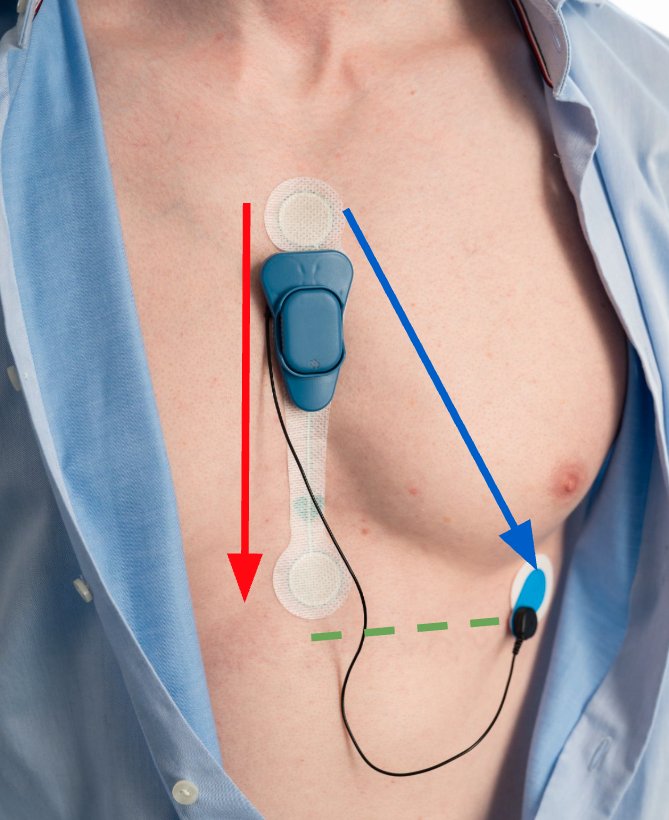
Byteflies has developed a Non-Linear Holter that utilizes a triangular, three-electrode configuration to capture multi-lead ECG data.
This multi-lead approach enhances signal amplitude and improves robustness against artifacts compared to standard setups. Consequently, it provides clearer visualization of ECG components thereby facilitating more accurate arrhythmia diagnosis.
Methods
A blinded, comparative study was conducted at Ghent University Hospital (UZ Gent) involving over 100 patients referred for ambulatory ECG monitoring.
- Study design: Each participant was monitored concurrently using both a standard single-lead ECG configuration and the Byteflies Non-Linear Holter. This allowed for a direct, intra-patient comparison of the data obtained from the Non-Linear Holter versus the single-lead method.
- Data Evaluation: The collected ECG data underwent a rigorous three-level evaluation process.
- Level 1: Automated algorithmic analysis
- Level 2: Review and annotation using the Byteflies clinical workflow, involving algorithms combined with expert ECG technician analysis.
- Level 3: Independent, blinded review of both single-lead and Non-Linear Holter data segments by experienced cardiologists at UZ Gent.
- Key Metrics: Evaluation focused on:
- Signal Quality (percentage of usable data, noise levels).
- Arrhythmia detection (burden, specific event counts).
- Interpretability of critical waveforms (P-waves, QRS complexes).
- Confidence ratings from ECG experts (Level 2) on quality of annotation based on data
- Confidence ratings from independent cardiologists (Level 3) regarding data quality, event detection, ease of decision making and treatment planning based on data.
- Signal Quality (percentage of usable data, noise levels).
Key Results
- Improved signal quality for non-linear setup (Level 1): Non-linear multi-lead recordings had significantly more analyzable data (p < 0.0001) and lower overall noise levels (p < 0.0001).
- Increased expert confidence in multi-lead data(Level 2): Byteflies ECG experts expressed significantly higher confidence in the multi-lead annotations than in the single-lead counterparts (p = 0.0252).
- Higher cardiologist confidence ratings (Level 3): Multi-lead ECGs were rated as significantly higher confidence (p < 0.001) for:
- Data quality,
- Event detection
- Ease of decision-making based on data
- Treatment plan based on data
- Impact on diagnosis and treatment (Level 3):
- For 13% of patients, clinically relevant arrhythmias were detected exclusively in the multi-lead data.
- Importantly, in 9% of cases, patients subsequently required anti-arrhythmic therapy.
- Cardiologist preference for multi-lead: In 31% of cases, when assessing single-lead data, cardiologists expressed a preference for multi-lead ECGs for the patient.
- Enhanced P-wave clarity as rated by cardiologists (Level 3): Multi-lead ECG recordings yielded a significantly higher proportion of P-waves classified as "Interpretable" by cardiologists (p ≈ 0.031).
Figures
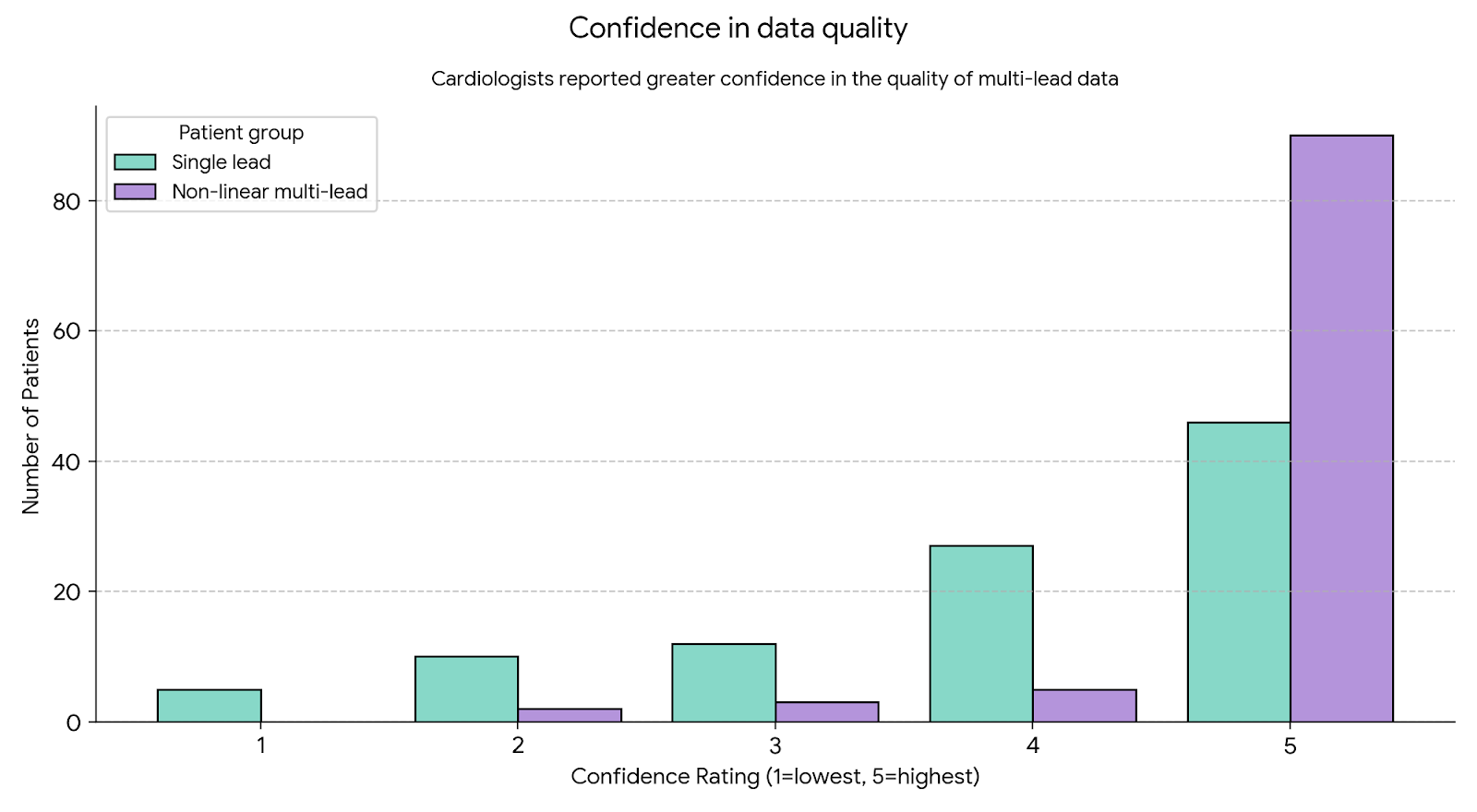
Confidence in Data Quality. Clinicians expressed significantly greater confidence in the data quality from the non-linear multi-lead system versus single-lead. This difference in the distribution of confidence ratings was statistically significant (p<0.001, chi-square test).
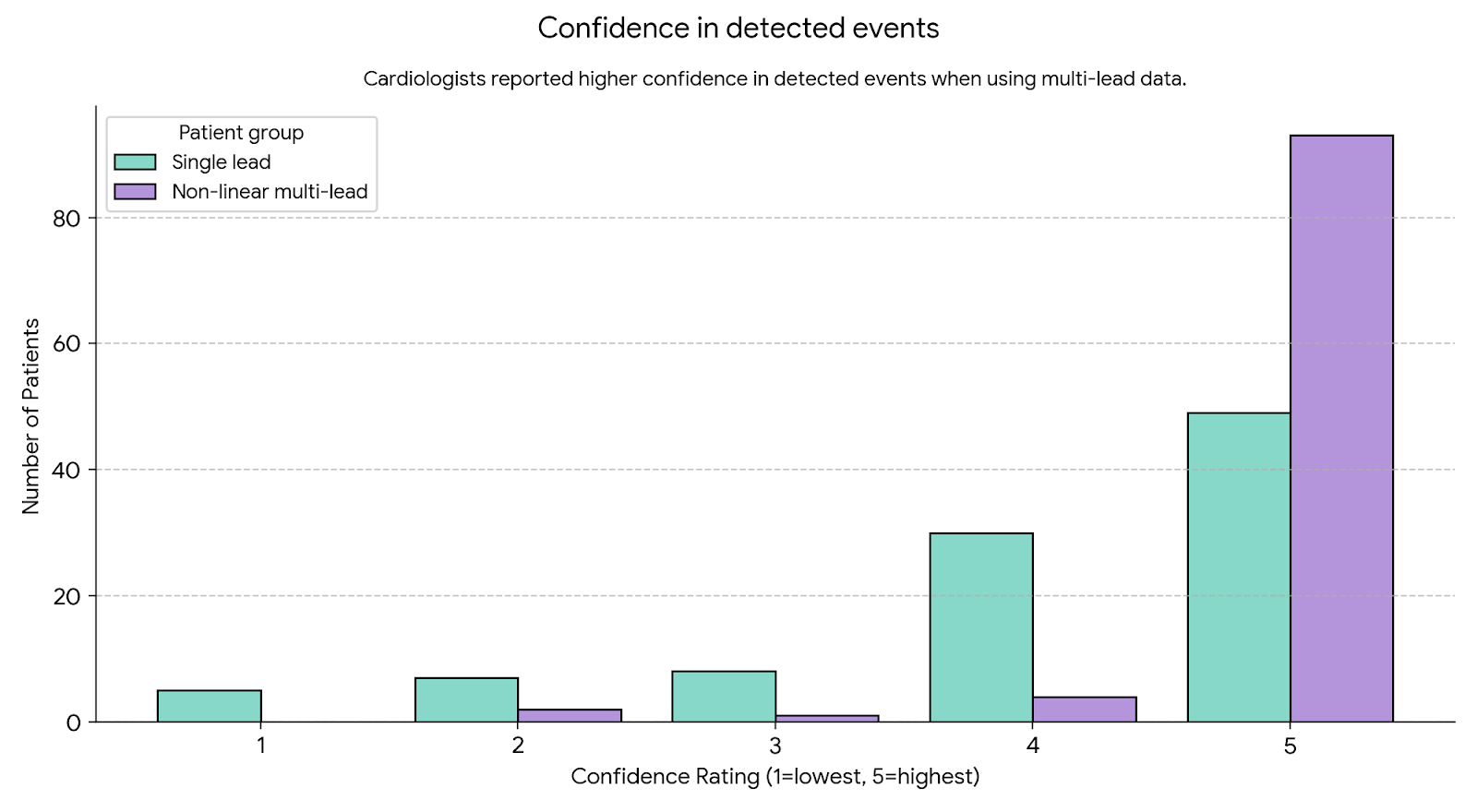
Confidence in Detected Events. Clinician confidence ratings for detected events were significantly higher when using the non-linear multi-lead system (p<0.001, chi-square test).

Ease of Reaching a Decision. Reaching a clinical decision was rated as significantly easier by clinicians when using data from the non-linear multi-lead system compared to single-lead (p<0.001, chi-square test).
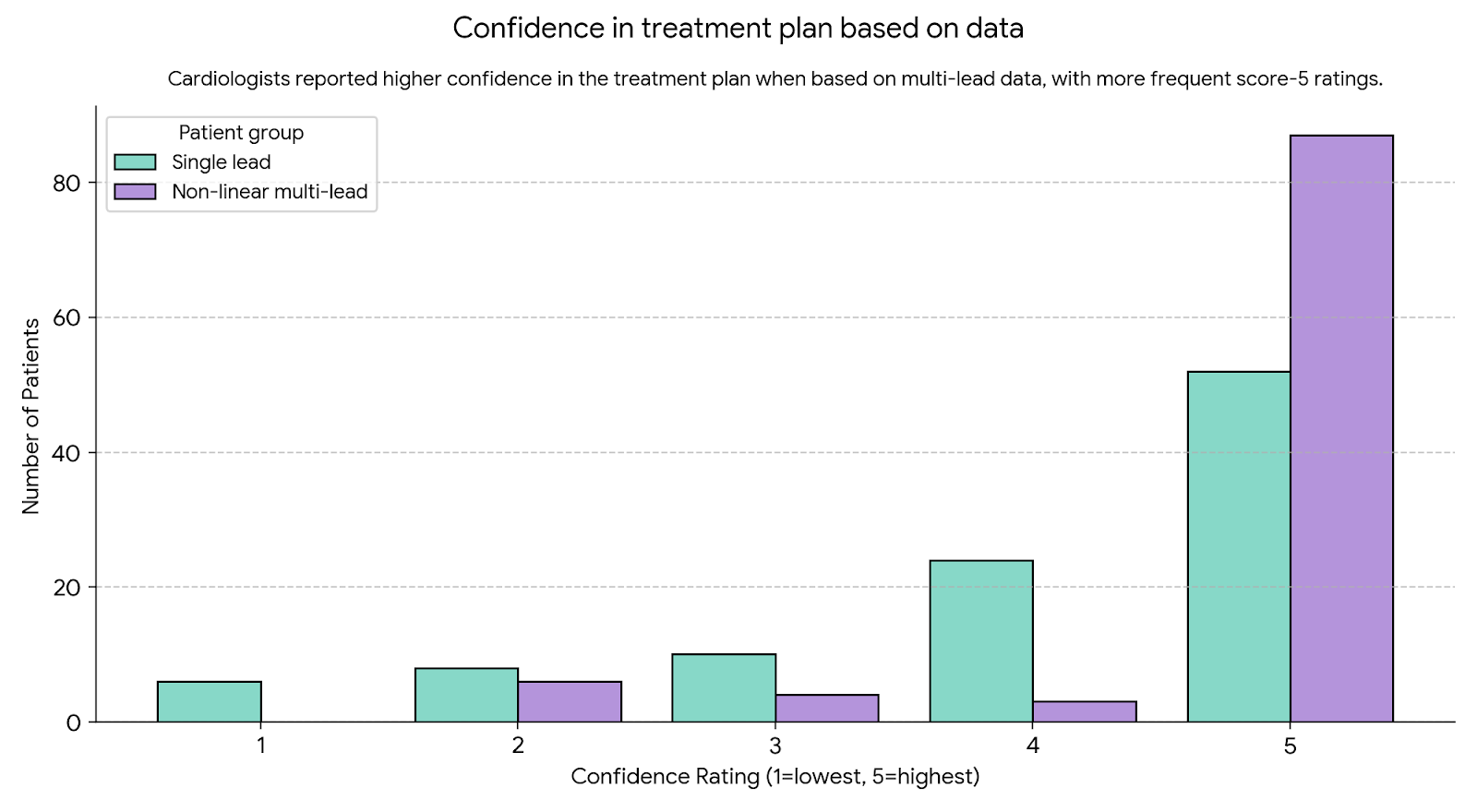
Confidence in treatment plan based on data.Clinicians had significantly higher confidence formulating treatment plans based on non-linear multi-lead data, assigning the highest possible score (5) more frequently.
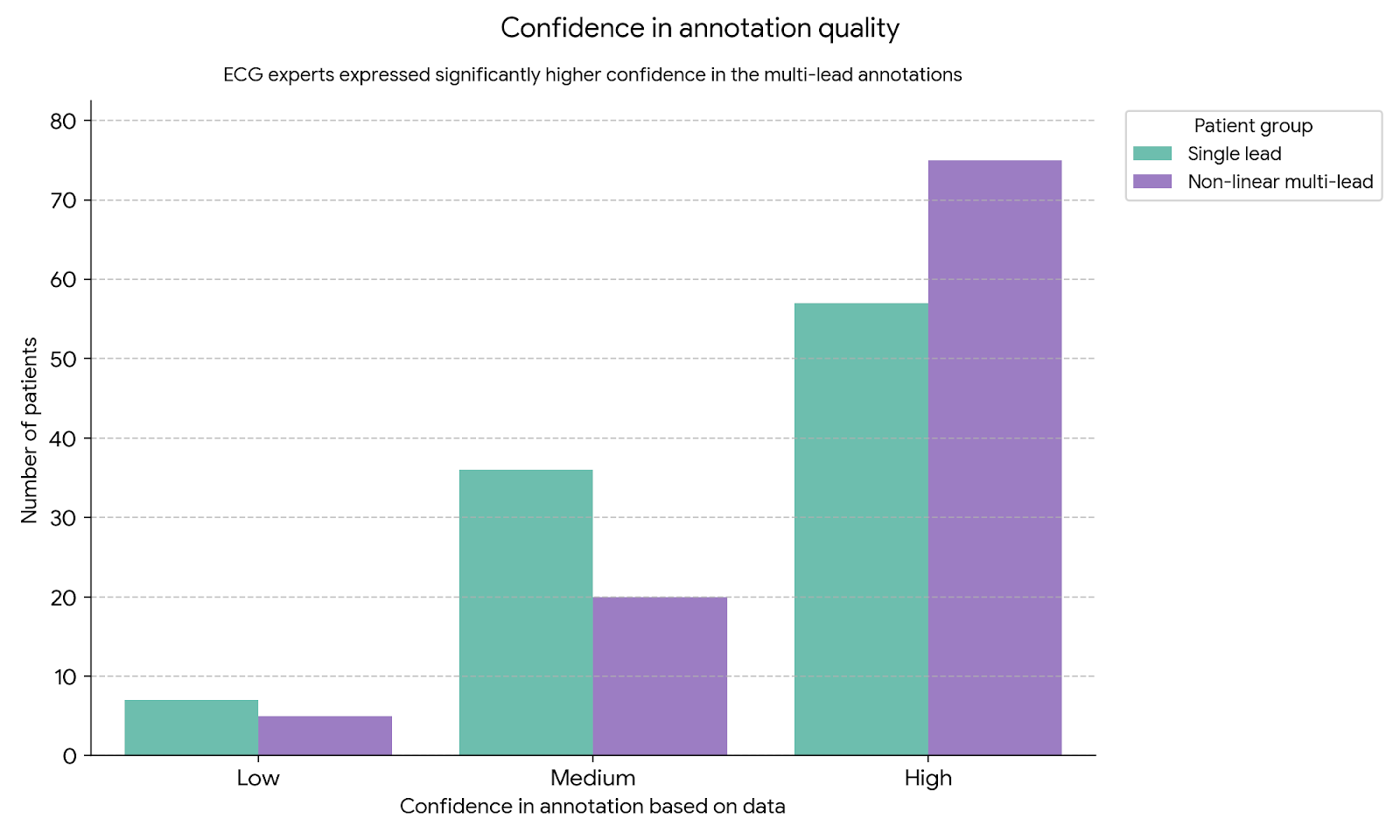
Confidence in annotation quality based on data. Byteflies ECG experts expressed significantly higher confidence in the multi-lead annotations than in the single-lead counterparts (p = 0.0252).
Individual case studies
Case 1:
While the single-lead tracing initially suggested SVT, the non-linear multi-lead recording provided critical clarification for diagnostic purposes, revealing the arrhythmia as ventricular tachycardia (VT).
Single Lead:
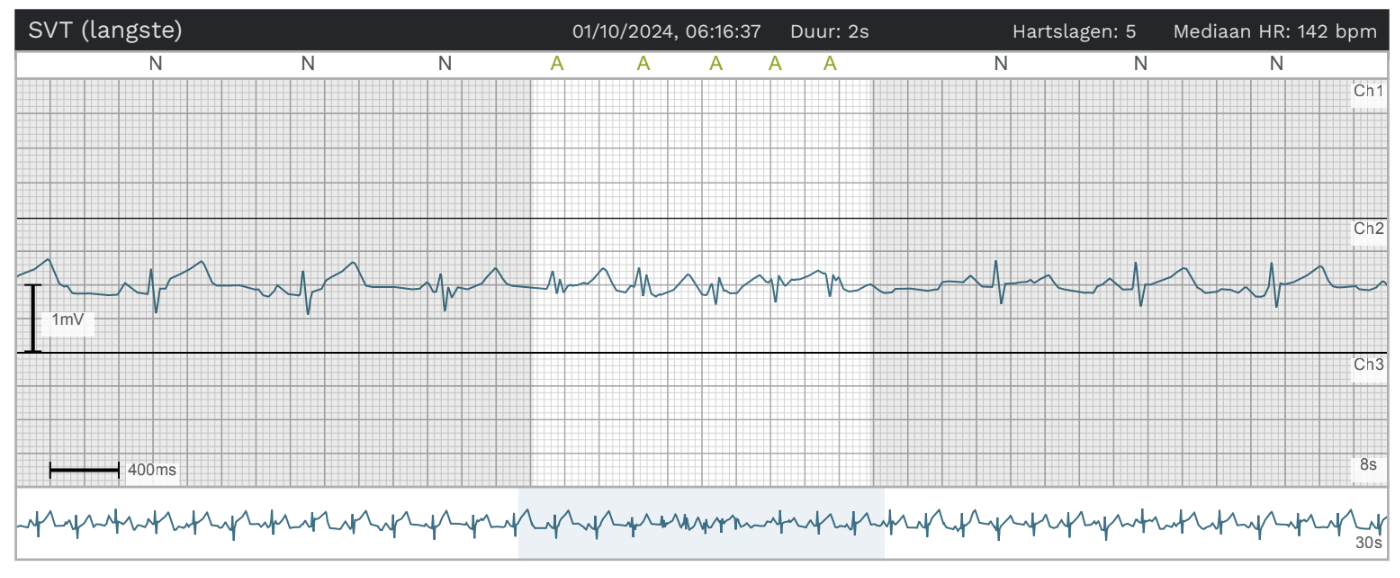
Non-Linear Multi-Lead:
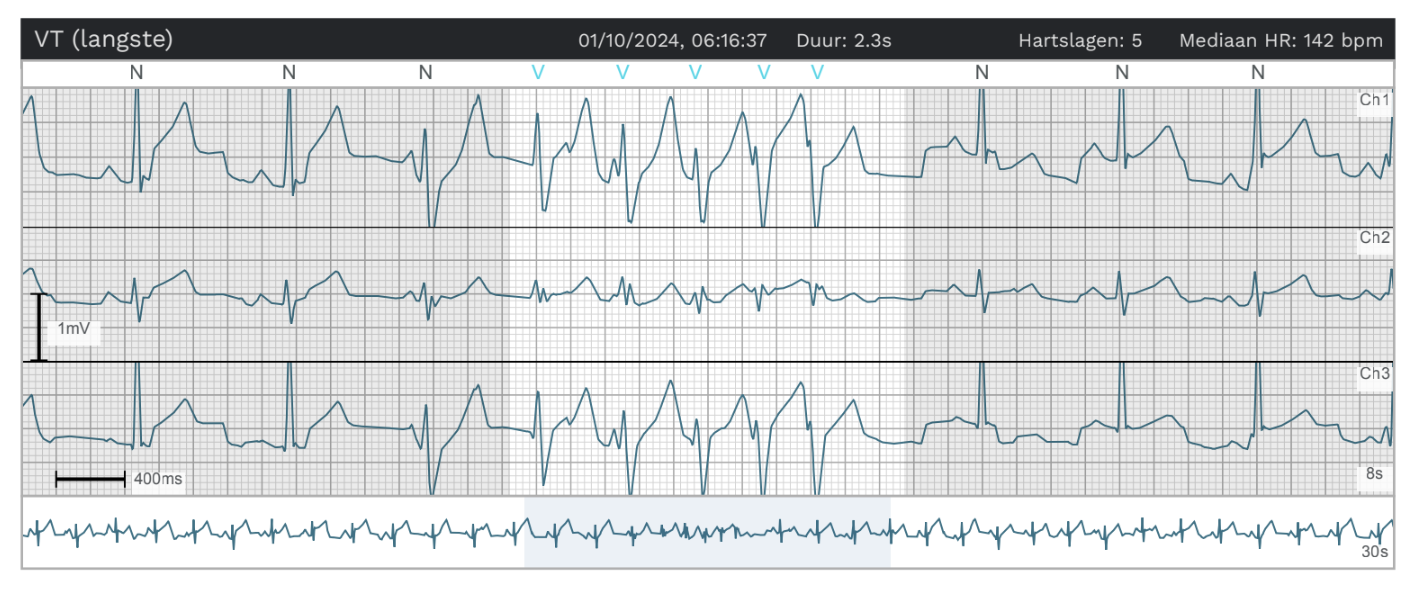
Case 2:
Enhanced signal clarity in the non-linear multi-lead recording facilitated accurate beat discrimination during supraventricular tachycardia (SVT) episodes, particularly at peak heart rates. This prevented the potential misclassification of supraventricular beats as ventricular, an ambiguity present in the concurrent single-lead tracing. Consequently, the accurate rhythm interpretation and clear visible P-waves in the multi-lead recording justified a clinical approach of no immediate treatment for non-sustained SVT of 11 beats, potentially averting unnecessary intervention that might have been considered based solely on the less clear single lead data.
Single Lead:
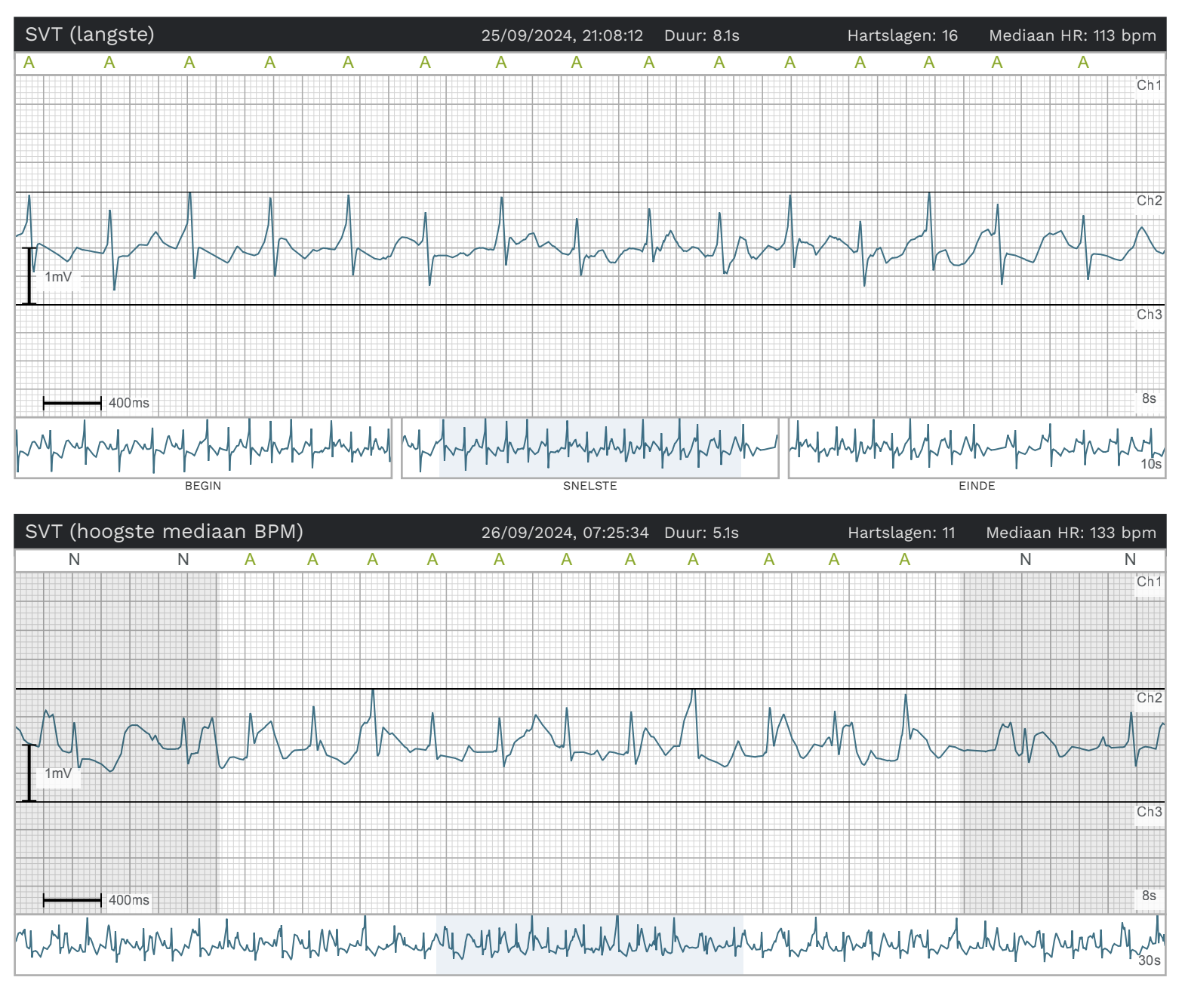
Non-Linear Multi-Lead:
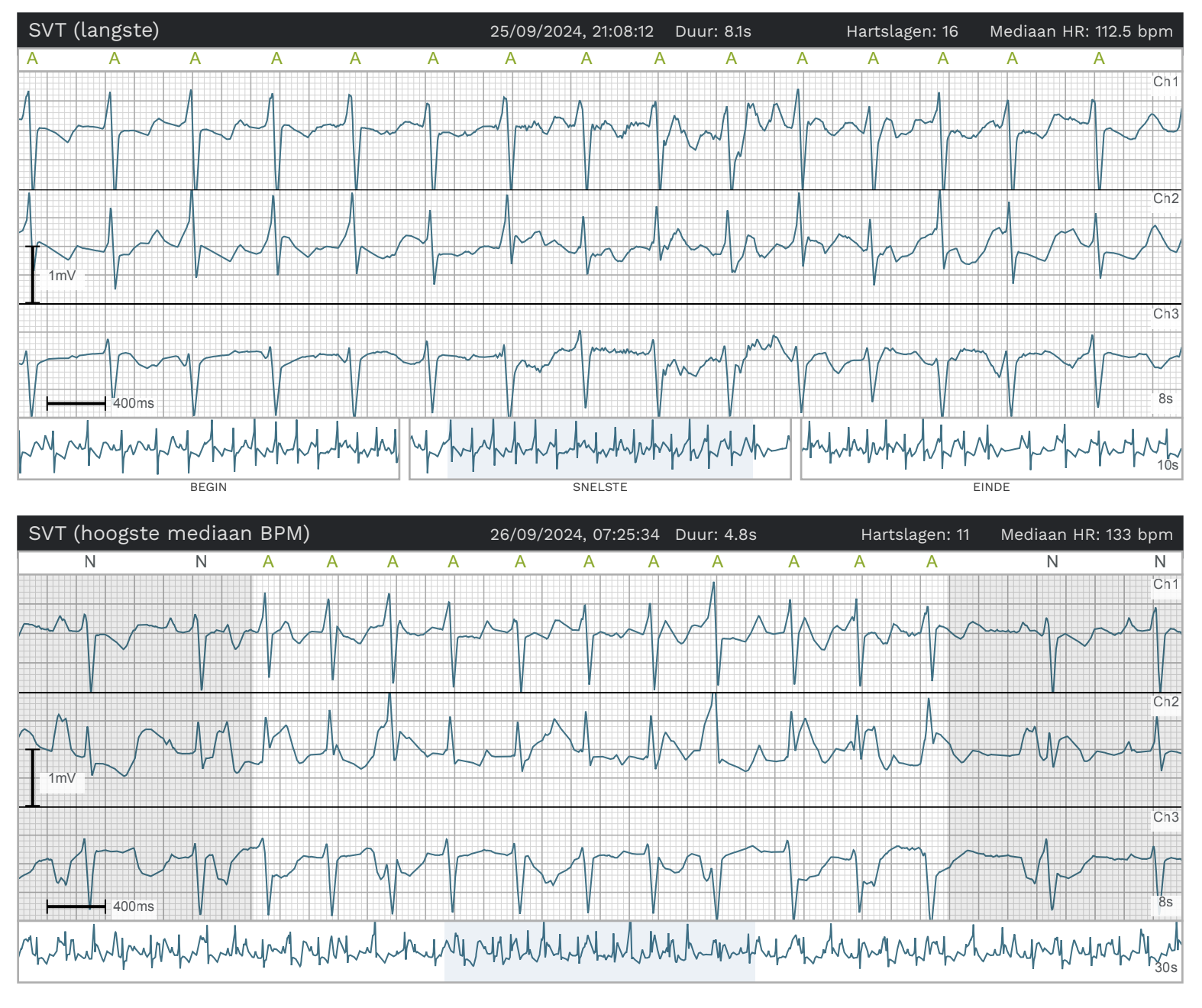
Discussion
The results from this comparative study demonstrate the significant clinical advantages of the Byteflies Non-Linear Holter across multiple dimensions of cardiac monitoring. After independent, blinded data review cardiologists expressed significantly higher confidence in the quality of data, the reliability of detected events, and the ease of clinical decision-making when using the Byteflies Non-Linear Holter compared to a standard single-lead approach.
This increased confidence is supported by objective metrics showing superior signal quality, including significantly more analyzable data and lower noise levels in the multi-lead recordings.
Furthermore, the enhanced clarity of P-waves and higher confidence ratings from ECG experts regarding annotation quality contribute to a more robust interpretation foundation. The clinical significance is highlighted by the 13% of patients for whom multi-lead data proved essential for diagnosis, and the 31% of cases where cardiologists explicitly preferred multi-lead data when initially reviewing single-lead tracings. The case studies further exemplify situations where critical arrhythmias were accurately identified only with the multi-lead system.
While this study focused on diagnostic accuracy and clinician confidence, the findings strongly suggest potential improvements in both clinical workflow and patient outcomes. For clinicians, the enhanced clarity and reduced noise of the multi-lead data may translate to more efficient interpretation, minimizing time spent on ambiguous tracings and potentially reducing the need for repeat testing or additional diagnostics. For patients, the ability to reach a definitive diagnosis more quickly and reliably supports earlier initiation of appropriate treatment. Further studies are needed to quantify these long-term outcome benefits.
Overall, the study underscores the role of high-fidelity monitoring, exemplified here by the Byteflies Non-Linear Holter, as a crucial decision-support tool that enhances diagnostic accuracy and clinician confidence over common single-lead methods.
Conclusion
The comparative study conducted at UZ Gent demonstrates that the Byteflies Non-Linear Holter directly addresses a limitation of conventional single-lead ambulatory ECG monitoring: inconsistent signal quality and its impact on clinical interpretation. This study provides compelling evidence that multi-lead, Non-Linear Holter monitoring represents a significant advancement in ambulatory arrhythmia detection, offering clinicians a more reliable tool for decision-making.
Interested in knowing more?
To learn more about how the Byteflies Non-Linear Holter can enhance arrhythmia detection and improve diagnostic confidence in your clinical practice, please visit byteflies.com or contact our team directly at hello@byteflies.com
Request sample patient reports:
Full reports available for all flows.
See what you can expect from our data & insight collection.

Executive Summary
While single-lead wearable ECG monitors are widely used, their ability to consistently capture clinically actionable data can be limited by signal quality. This paper presents findings from a 100-patient comparative study conducted at the Ghent University Hospital (UZ Gent). The study specifically evaluated the Byteflies Non-Linear Holter, a novel multi-lead wearable ECG monitor utilizing a triangular electrode configuration. Compared to simultaneous recordings from a representative single-lead ECG configuration, the Byteflies Non-Linear Holter demonstrated a higher amount of analyzable data, enhanced P-wave clarity, and significantly higher diagnostic confidence among expert cardiologists reviewing the data. Importantly, in 13% of patients, multi-lead data was essential to reach a clinically relevant decision. These results suggest the Byteflies’ Non-Linear Holter facilitates more reliable cardiac rhythm interpretation, directly supporting improved clinical decision-making compared to standard single-lead approaches.
Background / Clinical Context
In patients presenting with symptoms suggestive of cardiac arrhythmias, continuous ambulatory ECG monitoring can provide critical diagnostic insight, especially when brief, in-clinic ECGs or standard hospital telemetry may be insufficient. Wearable ECG monitors enable this type of continuous assessment, but signal quality, especially from single-lead setups, can suffer due to noise, motion artifacts, or anatomical variability. Inaccurate or unclear ECG traces can undermine clinician confidence and lead to missed or unnecessary interventions.
Technology Overview: The Byteflies Non-Linear Holter

Byteflies has developed a Non-Linear Holter that utilizes a triangular, three-electrode configuration to capture multi-lead ECG data.
This multi-lead approach enhances signal amplitude and improves robustness against artifacts compared to standard setups. Consequently, it provides clearer visualization of ECG components thereby facilitating more accurate arrhythmia diagnosis.
Methods
A blinded, comparative study was conducted at Ghent University Hospital (UZ Gent) involving over 100 patients referred for ambulatory ECG monitoring.
- Study design: Each participant was monitored concurrently using both a standard single-lead ECG configuration and the Byteflies Non-Linear Holter. This allowed for a direct, intra-patient comparison of the data obtained from the Non-Linear Holter versus the single-lead method.
- Data Evaluation: The collected ECG data underwent a rigorous three-level evaluation process.
- Level 1: Automated algorithmic analysis
- Level 2: Review and annotation using the Byteflies clinical workflow, involving algorithms combined with expert ECG technician analysis.
- Level 3: Independent, blinded review of both single-lead and Non-Linear Holter data segments by experienced cardiologists at UZ Gent.
- Key Metrics: Evaluation focused on:
- Signal Quality (percentage of usable data, noise levels).
- Arrhythmia detection (burden, specific event counts).
- Interpretability of critical waveforms (P-waves, QRS complexes).
- Confidence ratings from ECG experts (Level 2) on quality of annotation based on data
- Confidence ratings from independent cardiologists (Level 3) regarding data quality, event detection, ease of decision making and treatment planning based on data.
- Signal Quality (percentage of usable data, noise levels).
Key Results
- Improved signal quality for non-linear setup (Level 1): Non-linear multi-lead recordings had significantly more analyzable data (p < 0.0001) and lower overall noise levels (p < 0.0001).
- Increased expert confidence in multi-lead data(Level 2): Byteflies ECG experts expressed significantly higher confidence in the multi-lead annotations than in the single-lead counterparts (p = 0.0252).
- Higher cardiologist confidence ratings (Level 3): Multi-lead ECGs were rated as significantly higher confidence (p < 0.001) for:
- Data quality,
- Event detection
- Ease of decision-making based on data
- Treatment plan based on data
- Impact on diagnosis and treatment (Level 3):
- For 13% of patients, clinically relevant arrhythmias were detected exclusively in the multi-lead data.
- Importantly, in 9% of cases, patients subsequently required anti-arrhythmic therapy.
- Cardiologist preference for multi-lead: In 31% of cases, when assessing single-lead data, cardiologists expressed a preference for multi-lead ECGs for the patient.
- Enhanced P-wave clarity as rated by cardiologists (Level 3): Multi-lead ECG recordings yielded a significantly higher proportion of P-waves classified as "Interpretable" by cardiologists (p ≈ 0.031).
Figures

Confidence in Data Quality. Clinicians expressed significantly greater confidence in the data quality from the non-linear multi-lead system versus single-lead. This difference in the distribution of confidence ratings was statistically significant (p<0.001, chi-square test).

Confidence in Detected Events. Clinician confidence ratings for detected events were significantly higher when using the non-linear multi-lead system (p<0.001, chi-square test).

Ease of Reaching a Decision. Reaching a clinical decision was rated as significantly easier by clinicians when using data from the non-linear multi-lead system compared to single-lead (p<0.001, chi-square test).

Confidence in treatment plan based on data.Clinicians had significantly higher confidence formulating treatment plans based on non-linear multi-lead data, assigning the highest possible score (5) more frequently.

Confidence in annotation quality based on data. Byteflies ECG experts expressed significantly higher confidence in the multi-lead annotations than in the single-lead counterparts (p = 0.0252).
Individual case studies
Case 1:
While the single-lead tracing initially suggested SVT, the non-linear multi-lead recording provided critical clarification for diagnostic purposes, revealing the arrhythmia as ventricular tachycardia (VT).
Single Lead:

Non-Linear Multi-Lead:

Case 2:
Enhanced signal clarity in the non-linear multi-lead recording facilitated accurate beat discrimination during supraventricular tachycardia (SVT) episodes, particularly at peak heart rates. This prevented the potential misclassification of supraventricular beats as ventricular, an ambiguity present in the concurrent single-lead tracing. Consequently, the accurate rhythm interpretation and clear visible P-waves in the multi-lead recording justified a clinical approach of no immediate treatment for non-sustained SVT of 11 beats, potentially averting unnecessary intervention that might have been considered based solely on the less clear single lead data.
Single Lead:

Non-Linear Multi-Lead:

Discussion
The results from this comparative study demonstrate the significant clinical advantages of the Byteflies Non-Linear Holter across multiple dimensions of cardiac monitoring. After independent, blinded data review cardiologists expressed significantly higher confidence in the quality of data, the reliability of detected events, and the ease of clinical decision-making when using the Byteflies Non-Linear Holter compared to a standard single-lead approach.
This increased confidence is supported by objective metrics showing superior signal quality, including significantly more analyzable data and lower noise levels in the multi-lead recordings.
Furthermore, the enhanced clarity of P-waves and higher confidence ratings from ECG experts regarding annotation quality contribute to a more robust interpretation foundation. The clinical significance is highlighted by the 13% of patients for whom multi-lead data proved essential for diagnosis, and the 31% of cases where cardiologists explicitly preferred multi-lead data when initially reviewing single-lead tracings. The case studies further exemplify situations where critical arrhythmias were accurately identified only with the multi-lead system.
While this study focused on diagnostic accuracy and clinician confidence, the findings strongly suggest potential improvements in both clinical workflow and patient outcomes. For clinicians, the enhanced clarity and reduced noise of the multi-lead data may translate to more efficient interpretation, minimizing time spent on ambiguous tracings and potentially reducing the need for repeat testing or additional diagnostics. For patients, the ability to reach a definitive diagnosis more quickly and reliably supports earlier initiation of appropriate treatment. Further studies are needed to quantify these long-term outcome benefits.
Overall, the study underscores the role of high-fidelity monitoring, exemplified here by the Byteflies Non-Linear Holter, as a crucial decision-support tool that enhances diagnostic accuracy and clinician confidence over common single-lead methods.
Conclusion
The comparative study conducted at UZ Gent demonstrates that the Byteflies Non-Linear Holter directly addresses a limitation of conventional single-lead ambulatory ECG monitoring: inconsistent signal quality and its impact on clinical interpretation. This study provides compelling evidence that multi-lead, Non-Linear Holter monitoring represents a significant advancement in ambulatory arrhythmia detection, offering clinicians a more reliable tool for decision-making.
Interested in knowing more?
To learn more about how the Byteflies Non-Linear Holter can enhance arrhythmia detection and improve diagnostic confidence in your clinical practice, please visit byteflies.com or contact our team directly at hello@byteflies.com
Additional Audio resources:
